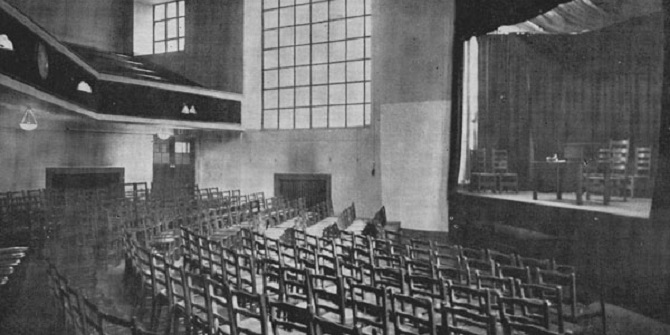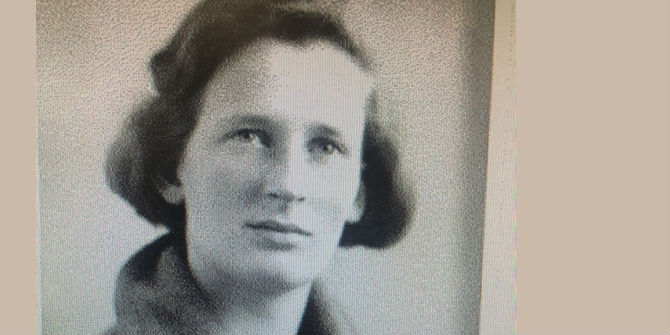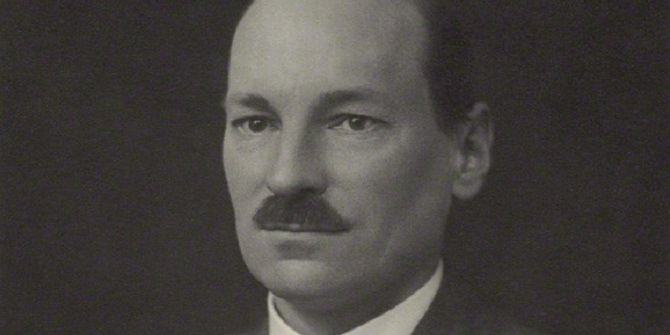Retired LSE academic Minnie Louise Haskins’ famous lines on “the gate of the year” have been used at royal occasions from George VI’s 1939 Christmas broadcast to the funeral of Elizabeth, the Queen Mother in 2002, writes LSE archivist Sue Donnelly.
And I said to the man who stood at the gate of the year:
‘Give me a light that I may tread safely into the unknown.’
And he replied:
‘Go out into the darkness and put your hand into the Hand of God. That shall be to you better than light and safer than a known way.’
So I went forth, and finding the Hand of God, trod gladly into the night. And He led me towards the hills and the breaking of day in the lone East.
Spoken by George VI in his Christmas 1939 broadcast to the Empire these words struck a chord with a country facing the uncertainly of war. They were the preamble to an obscure poem, God Knows, written in 1908, but nobody was able to identify the poet.
Finally at midnight on Boxing Day the BBC announced that the author was Minnie Louise Haskins, a retired LSE academic. The poem was just a small part of a career which had encompassed working in India and the East End, industrial welfare and academia.
Minnie Haskins was born and educated near Bristol where she studied informally at University College, Bristol while undertaking voluntary work for the local Congregational Church. By 1903 she was working in Lambeth for the Springfield Hall Wesleyan Methodist mission and in 1907 she departed for Madras with the Wesleyan Methodist Missionary Society to work in the Zenana mission to women.
In 1912, to raise funds, Minnie Haskins published a small volume of poetry The Desert which included the poem God Knows, originally written in 1908, to which she added the famous preamble.
In 1915 poor health led Minnie Haskins to return to England where she ran a munitions workers’ hostel in Woolwich for six months. This was followed by three years supervising the labour management department of a controlled factory in Silvertown, West Ham. Somehow she found time to publish a second volume of poetry The Potter in 1918.
At the age of 43 Minnie Haskins came to LSE to study for the Social Science Certificate under Agatha Harrison, who had been appointed in 1917 to the first British academic post devoted to industrial welfare. After gaining the Certificate with distinction in 1919 she took the Diploma in Sociology, gaining a further distinction in 1920. From 1919 to 1939 she worked as a tutor in the Social Science Department where the senior tutor described her as:
A woman of unusual capacity and character … a rare understanding and sympathy and infinite patience, combined with a great deal of love and interest in people.
Minnie Haskins was closely involved with the establishment of the Institute of Industrial Welfare Workers, the precursor to the Institute of Personnel Management, now the Chartered Institute of Personnel and Development, editing its monthly bulletin. In 1921 she published with Eleanor T Kelly Foundations of Industrial Welfare promoting “a spirit of co-operation” between worker and employer. At the same time Haskins wrote two novels Through Gates of Stone (1928) and A Few People (1932) and a further volume of poetry Smoking Flax (1942).
After her 1939 retirement Haskins returned to the School during the Second World War, finally retiring in 1944. She died in Kent and Sussex Hospital, Tunbridge Wells on 3 February 1957.
Her words live on, inscribed at the entrance to the George VI memorial chapel in St George’s Chapel, Windsor, and in a window at the Queen’s Chapel of the Savoy. The poem was read at the funeral of Elizabeth, the Queen Mother in 2002.







I suddenly thought of this poem ,as it was the last day of the year, and was so pleased to be able to Google the words, as the poem did not exist in any of my own poetry books. Thanks to Google and a happy New Year to everyone who reads this.
From: Julian Smith, LLB (1996)
Barrister (98 -)
Honorary Minister, Brixton Unitarians (92 -)
http://www.brixtonunitarians.org
We are very fond of this piece of poetry at Brixton Unitarians and have it read at the end of our Carols Service each year. It’ll be my 31st such service this year at 11:45am on the 17th November.
A Happy Christmas and Blessed New Year
Julian
I was 7yrs & 9mo when I heard the King’s uplifting Christmas message of1939. It was an unforgettable moment that defined the war to my child’s mind, What an extraordinary coincidence that he should have put those now famous words into the moment of our greatest peril.
I remember my Uncle receiving “I said to the man that stood at the gate of the year” in Chapel one Sunday morning when the gongregation were asked to say a verse. I was probably about 9 or 10 years old ( I am now 75) and I’ve never forgotten it. Then it came to me this morning ‘out of the blue’. So I Google it and read it all and it’s connetation. Wonderful
Although King George VI quoted these words in 1939, his speech was often re-broadcast from time to time during my childhood (I was born in 1940). The words always gave me goosebumps and instilled in me the sure knowledge that God can be trusted in even the darkest circumstances. In 2015 we are faced with another type of warfare – terrorism. The same God can be trusted to guide us through as He did then.
Very helpful and informative. Thank you
One of the most beautiful pieces that I have ever read.
Whilst watching the Queen’s 90th birthday celebratory service at St. Paul’s yesterday I first heard this poem being read very movingly by David Attenborough who is also now 90 years old and I heard this again today at St. John’s Church Wroxall, Isle of Wight by the priest so felt a continuity from St. Paul’s to St. John’s for our Queen’s thanksgiving service. It must resonate strongly with our Queen as read out at her own mother,s funeral.+ is inscrtibed at the entrance to her father’s George V1’s memorial chapel.
I have an old picture of this in an old wooden frame with her name on it broad cast
This poem is such a gift to us all.
Haskins, by then 64 years old, did not know that the King would quote her words, and did not hear the broadcast.
Would anyone happen to know if any of Minnie Louise Haskins books remain in print and where to find them? I would so like to own a copy or two of her works. I am a bit of a book hoarder!! I have looked on Forgottenbooks.com and they have nothing. I am only finding online versions of her poetry vs. an actual text. And, Amazon says they have 2 of her books but they are unavailable. Thank you so much for your help.
An ebook version is available here. Hope this helps. I’m thinking you’d really like a hard copy though!
https://www.fadedpage.com/showbook.php?pid=20150333
Aunt Minnie was one of the three ‘Aunts’ who brought up my father and uncle after they were sent back to England from India. We grew up with this poem and I’ve seen it at many cenotaphs in the past. She passed away a year after I was born. I was named after her sister Bridget, Aunt Biddy❤️, and my second sister and I had the honor of meeting her youngest sister, Aunt Edith, when we were 10 and eight years old. I’m so happy this poem has been loved so much. I’m sure Aunt Minnie would be delighted.
Just so beautiful.
I have known this beautiful poem for many years, even as a child. When I married I found a copy and put it in a frame. It was hung in the hall and was the first and last words I saw when entering and leaving.
I can still recall all the words and derive great comfort from them. What a wonderful person she must have been. God bless her.
I attended Thorney Close Secondary Modern girls School in Sunderland from 1960 -1964. Each morining in assembly a pupil was chosen to recite this standing on the stage. This had been a requirement of our Head Teacher, Miss Lowery, during her term as Head Teacher for many years before I attended the school. Myself and my older sisters and ex school friends remember this so well and have always been able to recite this off by heart with fond memories.
I am the niece of Minnie Louise haskins
I am the great niece, my grandpa was her youngest brother.
I am her great, great niece. She was my great grandmother’s sister.
Your aunt sounds like a remarkable person .
Happy New year .
Beautiful poem…I would love to own her books…anyone know where I could purchase them…?
I have a scrap of paper with these words ‘I said to the man……………’ printed on. My father kept this little piece of paper in his wallet/pocket all through WW2. He had it framed on his desk until he died and I have it framed on my bedroom wall. A comfort and inspiration to so many people in different circumstances.
Saw a reference to this poem in today’s Guardian newspaper, in article by Nancy Banks-Smith, in relation of its use by The Queen’s father.I vaguely remembered its opening line, and googled to find a longer reading. I’m overcome with emotion- can other words give so much hope and comfort in these terrible days we’re living?
Iam reflecting on the Gate of the Year again amidst the SAR-2Cov aka, COVID-19 pandemic.
It is of comfort particular as it resonate with Psalm 119:105 “Your Word is a lamp onto my feet and a light on my path”.
We are again in the hand of He that had the whole world in His hand. The poem is comforting with the lockdown work at home situation that we are currently in.
God bless Ms. Minnie Louise Haskins of eternal memory.
Does the LSE have a copy of The Desert or know where a copy might be found?
In 2011, I made this lovely poem the heading to my Happy New Year letter that I sent to family and friends. I was so moved by her poem. I wrote in my letter, “When we pass through the gate of this new year, I recommend we do as the poet did. There is no better traveling companion and to have my hand in his as I walk along this new year path makes me feel safe. And it gives me the knowledge that I will find my way.” I have read all the comments and am moved even further (with emotion) by her life, character, and how this poem is so loved.
Today would have been my mother, Joyce May’s, 110th birthday (but she died in 2003). This poem meant so much to her, and consequently to me too, that I have posted it on my FB page. I read it at my mother’s funeral. The words are stirring and so meaningful. They have spanned the generations and brought peace of mind to so many readers.
Today would have been my mother (Joyce May)’s 110th birthday (she died in 2003). “The Gate of the Year” meant so much to her, and consequently me too. I read this lovely poem at her funeral and have posted her copy of it on my FB page today. The words are so meaningful and uplifting and give people comfort during times of peril.
My mother would have been 110 today, 9 November 2021, had she lived. But she died in 2003, and I read this beautiful poem at her funeral. It meant so much to her, and consequently to me too. It is an uplifting and meaningful poem which spans generations. Wonderful words by a talented poet.
Do any print copies of The Desert still exist? I can’t find record information on World Cat.I am curious about the origins of the poem that begins “May today there be peace within”. It’s been attributed to Minnie Louise Haskins, St. Therese of Lisieux, and St. Teresa of Avila.
I am also searching for the same origin of the poem “May today there be peace” which has been erroneously attributed to St Theresa of Avila, St Therese of Lisieux, and St. Theresa of Calcutta. Let me know if anyone finds the answer!
I first heard part of this poem years ago at the end of the movie, The Mortal Storm (1940). It has stayed with me ever since. Absolutely beautiful words.
I, as others, will search Haskins other works.
I am preparing an inspirational moment for our Hymn Sing on December 30, 2021 at our Seniors Residence. I have used this poem on several occasions in my ministry and find it to be a perfect inspirational thought as we enter the New Year in the midst of the Covid 19 Pandemic. Thank you so much for this informative background about the author,, Minnie Louise Haskins, which will add to our appreciation of these encouraging words.
I saw this recently and wanted to find out more about Minnie Haskins. Thank you for the information about her and the history of this poem. As others have mentioned in the comments they have this framed and hanging on the wall where they will see it throughout the day. I too shall do this. A good reminder to trust God. And I aspire to have the love and patience that Minnie had!